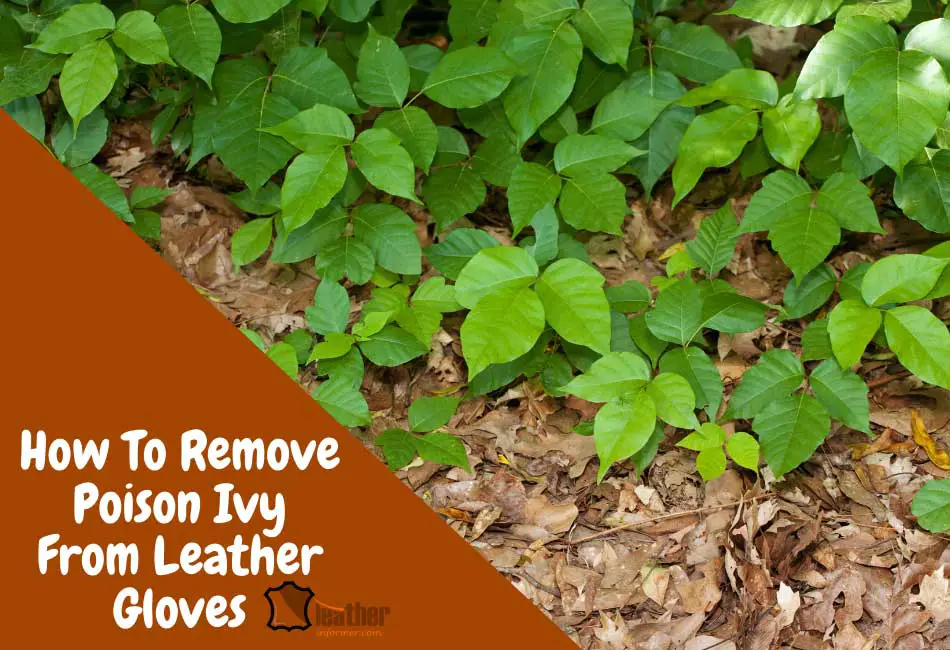If you’ve ever had the unfortunate experience of getting poison ivy on your skin, you know how irritating and itchy it can be. The good news is that there are ways to remove poison ivy from leather gloves, boots, or shoes – and I’m going to show you how!
In this article, I will discuss the different methods for removing poison ivy from leather gloves, boots, etc., as well as how to prevent it from happening in the first place. Let’s get started!
Poison Ivy On Leather Gloves And Boots
Since my family moved into our current home, we’ve had a problem with poison ivy.
It seems to grow everywhere – in the cracks of the sidewalk, the bushes by the house, and even in our backyard! We’ve tried all sorts of things to get rid of it, but nothing has worked.
The other day, I was out working in the yard, and I got poison ivy on my leather gloves.
Although I knew I had had contact with the plant, I didn’t think it would be such a big deal since I was wearing gloves. I was wrong!
As soon as I came inside, my hands started to itch and burn. I tried washing them with soap and water, but that only made the irritation worse.
I knew I needed to find a way to remove the poison ivy from my gloves – and fast!
Poison ivy is a plant that contains a chemical called urushiol. This substance can cause an allergic reaction when it comes into contact with the skin.
The symptoms of this reaction include itching, redness, swelling, and blisters. In severe cases, it can even lead to difficulty breathing and anaphylactic shock.
It is widespread to have poison ivy stains on leather gloves, boots, and shoes. This is because the urushiol can cling to these surfaces and be transferred to the skin.
And because leather is a porous material, poison ivy can seep deep into the pores and be difficult to remove.
But there are a few different methods that you can use to remove poison ivy from leather gloves.
How To Remove Poison Ivy From Leather Gloves And Boots
There are a few different methods that you can use to remove poison ivy from leather gloves.
1. Using White Vinegar
One of the most effective ways to remove poison ivy from leather gloves is to use white vinegar.
Vinegar is a natural acid that can break down the urushiol and remove it from the surface of your leather gloves, boots, etc., without causing any damage to the leather material.
- To use this method, dilute equal parts white vinegar and water in a bowl.
- Then, dip a clean cloth into the mixture and use it to wipe down the affected areas of your leather gloves.
- Let the vinegar solution sit on the gloves for a few minutes before wiping it off with another clean, damp cloth.
- Repeat this process until all of the poison ivy is removed from your gloves.
- Finish off by conditioning your leather gloves with a good leather conditioner to help restore their softness and flexibility.
2. Using Rubbing Alcohol
Another effective way to remove poison ivy from leather gloves is rubbing alcohol. This will help to break down the poison ivy oils stuck on your leather gloves. To use rubbing alcohol,
- Simply pour some onto a clean cloth and then rub it over the affected areas of your leather gloves.
- Make sure to do this in a well-ventilated area as the fumes from the rubbing alcohol can be strong.
- Once you have rubbed the affected areas with rubbing alcohol, rinse your gloves off with clean water.
- The best way to do this is to use a damp microfiber cloth or towel.
- Last but not least, apply your usual leather conditioner and allow your gloves to dry completely before wearing them again.
- This will help to keep your leather gloves in good condition and prevent the poison ivy oils from causing any irritation.
3. Using Dish Soap
Another method you can also use to remove poison ivy from leather gloves is dish soap. Dish soap is made to break down grease and oils, which makes it perfect for removing poison ivy oil from your leather gloves. To use dish soap;
- Add a small amount to a bowl of warm water and mix it.
- Then, use the mild dish solution to clean your leather items thoroughly.
- Once you have finished, rinse your gloves off with clean water and dry them with a soft cloth.
- As with the other methods, be sure to apply your usual leather conditioner after cleaning to keep your gloves in good condition.
4. Using Lemon Juice
Last but not least, you can use lemon juice to counteract the poison ivy oils on your leather gloves.
Lemon juice is a natural acid that can help to break down the urushiol and remove it from your gloves.
- All you have to do is to simply mix equal parts lemon juice and water in a bowl.
- Then, dip a soft cloth into the mixture and use it to wipe down the affected areas of your gloves.
- Leave the lemon juice solution on for a few minutes before rinsing it off with clean water and drying your gloves with a soft cloth.
- As always, don’t forget to apply some leather conditioner afterwards to keep your gloves in good condition.
What Happens If You Don’t Remove Poison Ivy From Leather Gloves?
If you don’t remove poison ivy from your gloves, there are a few things that could happen.
The first is that the poison ivy oils will eventually dry out and cause your gloves to crack and become brittle. This can cause irreparable damage to your gloves and render them unusable.
Another possibility is that the poison ivy oils will seep into your skin, causing a rash or even blisters.
So it’s important to take the necessary steps to remove poison ivy from your gloves as soon as possible.
By following the above steps, you can easily remove poison ivy from leather gloves without causing any damage to them.
Final Thoughts
Poison ivy is a pesky plant that can cause a lot of problems if you’re not careful.
But by taking the necessary precautions and knowing how to remove poison ivy from leather gloves, you can avoid any issues.
Do you have any tips for removing poison ivy from leather gloves? Share them in the comments below!

